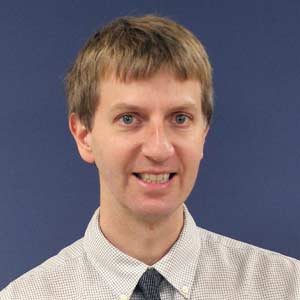Universal Design for Learning (UDL) is a framework to improve and optimize teaching and learning for all people based on scientific insights into how humans learn. In 2017, with support from the Davis Educational Foundation, Goodwin College established its first cohort of instructors to re-examine their teaching methods and to stretch themselves creatively in working with students of wide-ranging learning differences and educational experiences. Several of those instructors have agreed to be contributors to the Goodwin College blog.
Writing from the Inside Out
by Professor Randy Laist
Most of the time, when we talk about writing a sentence, we are likely to focus on the most visible aspects of the activity: the selecting and spelling of words, the management of grammatical conventions, and the expression of meaning. Obviously, these are all important elements of sentence-writing, but the more interesting and elusive work of writing is not happening on the page or computer screen, but in the writer’s brain or, more precisely, in the interaction between writing surface and the writing brain. A sentence comes about as the concretization of a confluence of neurological energies churning through the microstructure of the writer’s central nervous system. Certain words happen to be accessible, floating around in the sub-conscious like bits of debris drifting on a stormy sea. A tentative conception is half-formed in the neocortex of something that it makes sense to try to say. A general body-feeling of wellbeing or discomfort, confidence or anxiety, obligation or curiosity, holds the entire project in its indomitable sway. The sentence channels all of these elements into its formalized structure, like a snapshot of a hurricane — congealing all of the turbulent randomness of pure thinking into something capable of bearing meaning, something that other people can understand, and something that actually gives expression and order to the amorphous experience of consciousness itself. A sentence pins thought to the wall, securing it into place in a way that allows it to become a kind of starting point for another sentence, another frozen thought, one capable of doing something with the previous thought — elaborating, refining, qualifying, or contradicting it, and, in any case, heightening its level of complexity. This “ratchet effect” allows relatively mundane sentences to become the starting point for revolutionary ideas, and it is the mechanism that results not only in “good” writing, but also in the intellectual development of individual human beings as well as the technological and civilizational advancement of the human species as a whole, that tribe of mammals that learned how to harness the power of writing to re-make the face of the entire planet.
Conventional writing instruction has a lot to say about the “visible” aspects of writing. Writing students can reliably expect to receive detailed feedback on their vocabulary, their grammar, and the content of their sentences. The less visible aspects of writing, however, receive relatively little attention, for obvious reasons. Visible things are easier to talk about than invisible things, and, more fundamentally, our understanding of the underlying neuro-dynamics of the writing process is woefully underdeveloped. Writing classes however, whether they are English classes or intradisciplinary writing classes, are ideal environments for inviting students down into the rabbit-hole of their own motivational architecture. The student — the student’s brain, the student’s voice, the student’s way of perceiving the world — constitutes the curriculum of a writing class. Any meaningful writing instruction begins when a student looks into her heart and asks herself what she wants to write about. In the process of doing so, she begins to build conceptual bridges between her own self-understanding and the world around her, an endeavor that enhances her understanding of both herself and her world. Any sentences that she writes as the result of these reflections will take their meaning from this deep cognitive under-structure, even as they serve to direct and shape the evolution of her ideas.
With its emphasis on representational flexibility, student-centered instruction, and personal engagement, Universal Design for Learning (UDL) provides a framework within which writing teachers can experiment with techniques for teaching writing “from the inside out,” rather than from the outside in. My participation in the first UDL cohort at Goodwin College has provided me with the resources and support to develop an “inspiration-based” writing curriculum for freshman students. In the revised model of English 101, students spend the first week examining their own interests and enthusiasms to identify a topic that they are deeply curious about, then they spend the rest of the semester channeling that curiosity into a variety of writing projects that challenge them to develop their understanding of their topic in new directions. The topics they choose — mermaids, Halloween, mass-incarceration, coffee, Henrietta Lacks — are as diverse and surprising as the students themselves, and their writing has consistently demonstrated a degree of rigor and thoughtfulness that belies their status as introductory-level writing students. With the help of a structured sequence of assignments, clear expectations, and continuous encouragement, these students use writing as a tool to develop genuine expertise in a range of subjects. The results of the revised curriculum resoundingly demonstrate the pedagogical advantages that can accrue when writing instructors tap into the deep structure of student motivation.
Randy Laist is an associate professor of English at Goodwin College. He is the author of Technology and Postmodern Subjectivity in Don DeLillo’s Novels (2010) and Cinema of Simulation: Hyperreal Hollywood in the Long 1990s (2015). He is also the editor of Looking for Lost: Critical Essays on the Enigmatic Series (2011), Plants and Literature: Essays in Critical Plant Studies (2013) and College in the Movies: Representations of Higher Education in Cinema (forthcoming).
The grant was received from the Davis Educational Foundation established by Stanton and Elizabeth Davis after Mr. Davis’ retirement as chairman of Shaw’s Supermarkets, Inc.

Randy Laist is a professor of English at Goodwin University. He is the author of Technology and Postmodern Subjectivity in Don DeLillo’s Novels (2010), Cinema of Simulation: Hyperreal Hollywood in the Long 1990s (2015), and The Twin Towers in Film: A Cinematic History of the World Trade Center (2020). He is also the editor of Looking for Lost: Critical Essays on the Enigmatic Series (2011), Plants and Literature: Essays in Critical Plant Studies (2013), College in the Movies: Representations of Higher Education in Cinema (2018), Excavating Indiana Jones: Essays on the Films and Franchise (2020), and Imagining the 1980s: Representations of the Reagan Decade in Popular Culture forthcoming).

